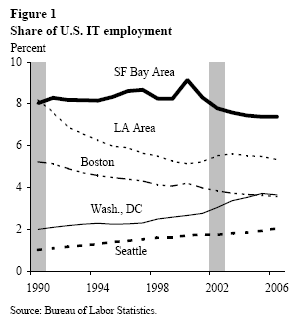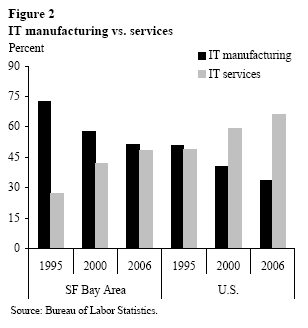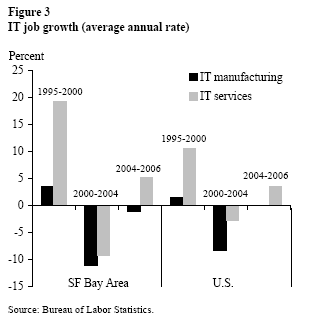The San Francisco Bay Area has long been a key center of information technology (IT) innovation and production. This Economic Letter explores how IT employment trends have evolved in this area, as well as how they compare to other key IT centers and the nation.
- Bay Area’s share of IT employment, 1990-2006
- Changing composition of IT employment
- Importance of IT to the Bay Area
- Conclusion
- References
|
The San Francisco Bay Area has long been a key center of information technology (IT) innovation and production. This Economic Letter explores how IT employment trends have evolved in this area, as well as how they compare to other key IT centers and the nation. The findings show that, although the region has seen a modest decline in its share of the nation’s IT jobs while other key centers have seen gains, the Bay Area remains the national leader in IT employment. In particular, sectoral shifts from IT manufacturing to IT services within the Bay Area over the last decade, coupled with above-average job growth in several key IT services in recent years, have helped maintain the Bay Area’s advantage in IT employment nationally. Not surprisingly, the Bay Area IT sector continues to be a key source of strength for the region’s economy.
Bay Area’s share of IT employment, 1990-2006
For the purposes of this analysis, IT will be divided into two broad components: manufacturing and services. The IT manufacturing component includes companies that make computers, communications equipment and their primary building blocks, semiconductors, and other advanced electronic machinery, as well as a variety of advanced measuring and testing equipment, such as photonics and electrometrical and aeronautical devices, along with consumer electronics (Daly and Valletta 2004). The IT services component includes internet service providers and computer programming, design, management services, and research and engineering services.
 Figure 1 provides telling evidence on the evolution of IT employment trends in the Bay Area as well as on the region’s long dominance as a leader in IT employment. The figure plots the share of the nation’s IT employment from 1990 to 2006 for the five metropolitan areas cited among the nation’s largest centers for IT employment by the American Electronics Association (2000). This 16-year period covers the years leading up to a productivity surge that was largely driven by developments in IT, the dot-com boom, the recession in 2001-2002, which was largely led by a retrenchment in IT investment (marked by the second gray bar in the figure), and the subsequent recovery.
Figure 1 provides telling evidence on the evolution of IT employment trends in the Bay Area as well as on the region’s long dominance as a leader in IT employment. The figure plots the share of the nation’s IT employment from 1990 to 2006 for the five metropolitan areas cited among the nation’s largest centers for IT employment by the American Electronics Association (2000). This 16-year period covers the years leading up to a productivity surge that was largely driven by developments in IT, the dot-com boom, the recession in 2001-2002, which was largely led by a retrenchment in IT investment (marked by the second gray bar in the figure), and the subsequent recovery.
Although the Bay Area has seen a fall in its share of the nation’s IT employment, it nonetheless has been the leader among metropolitan areas throughout this period of booms and busts in the industry, and remains so today. Shares also have shifted for the other top IT centers. For example, although Los Angeles has maintained its second-place ranking, its share of the nation’s IT employment has fallen. The Boston area, too, has seen some erosion in its IT employment share, and, indeed, it has ceded its third-place ranking to Washington, D.C., where the share has risen. Seattle remains in the fifth-place position, with its share showing a steady upward movement.
Regarding the Bay Area, the figure shows that its share of the nation’s IT jobs hovered around 8% throughout most of the 1990s before spiking to just above 9% in 2000, at the tail-end of the IT boom. This was a period of rapid deployment of internet-related services, which ushered in a new era of commerce conducted not in brick-and-mortar stores but on the World Wide Web. When the dot-com boom turned to a bust, amid the more general decline in IT investment nationally, the Bay Area’s share of the U.S. IT labor force fell and today has leveled off to 7%, a touch below what it was in the early 1990s.
Changing composition of IT employment
To understand why these shifts have occurred, it is useful to look at the changing composition of IT employment, which has been driven by the ongoing transformation of the IT sector. Since the inception of microprocessor manufacturing in Silicon Valley, the nucleus of the Bay Area IT center, the U.S. IT sector has been characterized by rapid advances in technology and the emergence of new products and applications. What began as an industry associated with the development of faster microprocessors and the production of personal computers has increasingly become software-oriented, as the personal computer has evolved into a general-purpose machine to which new functions can be added simply by installing new programming (Economist 2006). Likewise, the use of the internet and wireless communications has grown phenomenally. While the services component of IT has burgeoned, changes also have occurred in the manufacturing component. Globalization of the IT supply chain has shifted IT manufacturing production to new locations, often overseas, where labor is relatively inexpensive (Valletta 2003). These developments are reflected in the rising share of IT jobs in services compared to manufacturing in the U.S. and in the Bay Area.
 Figure 2 shows a decomposition of the IT sector into manufacturing and services for the Bay Area and the nation as a whole. In 1995, nearly three-quarters of Bay Area IT jobs were in manufacturing, while, at the national level, IT manufacturing jobs constituted about half of total IT employment. By 2006 the Bay Area IT sector had become more balanced in its mix of manufacturing and service jobs, though it remained relatively more focused on manufacturing than the nation. Though not shown, the data reflect similar developments in the other IT centers. Los Angeles and Boston, which have been more oriented toward manufacturing, have seen a decline in the share of the nation’s IT jobs, while Washington, D.C., and Seattle, which are more oriented toward the services component of IT, have seen their shares rise.
Figure 2 shows a decomposition of the IT sector into manufacturing and services for the Bay Area and the nation as a whole. In 1995, nearly three-quarters of Bay Area IT jobs were in manufacturing, while, at the national level, IT manufacturing jobs constituted about half of total IT employment. By 2006 the Bay Area IT sector had become more balanced in its mix of manufacturing and service jobs, though it remained relatively more focused on manufacturing than the nation. Though not shown, the data reflect similar developments in the other IT centers. Los Angeles and Boston, which have been more oriented toward manufacturing, have seen a decline in the share of the nation’s IT jobs, while Washington, D.C., and Seattle, which are more oriented toward the services component of IT, have seen their shares rise.
Despite the downshift in IT manufacturing jobs in the Bay Area, the erosion of its IT employment shares has been modest, in part because of the offsetting effect from faster-than-average growth in IT service jobs. Since the mid-1990s, IT service growth in the Bay Area has outpaced the U.S. average, while IT manufacturing jobs have fallen a bit faster than average.
 The growth rate for IT jobs during key subperiods since the mid-1990s is shown in Figure 3. In the 1995-2000 period, the Bay Area saw exceptional growth in IT service jobs and above-average growth in IT manufacturing jobs. During the 2000-2004 period, the erosion of shares also largely reflected the difference in its job growth compared to the national average. In the most recent period, above-average gains in IT service jobs have offset a somewhat larger contraction in IT manufacturing jobs, working to stabilize the Bay Area’s share of overall IT employment. Among IT services, the Bay Area’s edge over the nation has been due in part to the exceptional recovery and growth in jobs at firms providing internet-related services, such as web search portals and data processing.
The growth rate for IT jobs during key subperiods since the mid-1990s is shown in Figure 3. In the 1995-2000 period, the Bay Area saw exceptional growth in IT service jobs and above-average growth in IT manufacturing jobs. During the 2000-2004 period, the erosion of shares also largely reflected the difference in its job growth compared to the national average. In the most recent period, above-average gains in IT service jobs have offset a somewhat larger contraction in IT manufacturing jobs, working to stabilize the Bay Area’s share of overall IT employment. Among IT services, the Bay Area’s edge over the nation has been due in part to the exceptional recovery and growth in jobs at firms providing internet-related services, such as web search portals and data processing.
Importance of IT to the Bay Area
IT employment has long been important to the vigor of the Bay Area economy. Especially important in this regard has been the exceptional increase in earnings of the typical IT employee in the Bay Area. In 1990, the IT sector accounted for 8.8% of all jobs, and the share was only a bit higher, 9%, by 2005. During that period, however, the share of the dollar value of total wages and salaries in the Bay Area accounted for by the IT sector rose from 14.2% to 20%. By contrast, for the U.S., the increase in IT share of total wages and salaries over the period was more modest, from 6.7% to 8%. The gain in the role of IT in the Bay Area and the U.S. in large part reflects the gains in productivity in the IT sector compared to the other sectors of the economy as a whole.
The Bay Area has retained its prominence as the leading IT center nationwide. While giving some ground in terms of IT employment share, the Bay Area still accounts for 1.5 times more IT jobs than the second-ranked Los Angeles area. The region’s IT sector also has been shaped by the national trend in the growth of IT services. In fact, over the past several years, Bay Area IT service firms have added jobs at a faster pace than IT service firms in the nation as a whole. As a result, while the Bay Area today maintains its legacy in hardware development, the region has a more balanced mix of IT manufacturing and IT service jobs than in the mid-1990s. This transformation has been a key factor in the Bay Area’s success in retaining most of its share of overall IT employment in the U.S. Also, with a relatively stable share of IT employment combined with substantial gains in productivity, the IT sector has had a growing impact on the Bay Area economy, accounting for as much as 20% of the total wages and salaries of workers in the region.
Lily Hsueh
Regional Analyst
[URLs accessed June 2007.]
American Electronics Association. 2000. Cybercities: A City-by-City Overview of the High-Tech Industry. Washington, DC.
Daly, Mary C., and Robert G. Valletta. 2004. “Performance of Urban Information Technology Centers: The Boom, the Bust, and the Future.” FRB San Francisco Economic Review 2004, pp. 1-18.
The Economist. 2006. “The PC’s 25th Birthday–Getting Personal.” July 29, pp. 57-58.
Valletta, Robert G. 2003. “Is Our IT Edge Drifting Overseas?” FRBSF Economic Letter 2003-30 (October 10).
Opinions expressed in FRBSF Economic Letter do not necessarily reflect the views of the management of the Federal Reserve Bank of San Francisco or of the Board of Governors of the Federal Reserve System. This publication is edited by Anita Todd and Karen Barnes. Permission to reprint portions of articles or whole articles must be obtained in writing. Please send editorial comments and requests for reprint permission to research.library@sf.frb.org